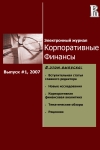Internal Inconsistency of Downside CAPM Models
Abstract
Author: Sergey Vasilyevich Cheremushkin - National Research University "Higher School of Economics"
There is little criticism of downside measures approach to estimating risk premiums. Instead, this model attracted attention of both academics and practitioners. For example, Abbas et al (2011) refer to DCAPM as “long-awaited solution for asset pricing problem”. Estrada (2006, 2007), Post and Vliet (2004) and some other researchers claim that downside approach is often preferable to the traditional CAPM. At the same time they keep silence about limitations of the model. This paper intends to fill the gap. It shows that downside CAPM approach produces instable results. Although there are various versions of downside risk measurement approaches, the focus of this paper is estimation of assets’ betas and risk premiums. Therefore we limit our review with DCAPM approach, which is the most popular today and is advised as a preferable method of estimating risk premiums at emerging markets. In this context the most critical issue is estimation of security characteristic line and the marginal contribution of an asset’s risk into the risk of benchmarking market portfolio.We construct a portfolio of two assets using different weights and calculate its true semideviation and semideviation according to DCAPM framework. Then we change data to obtain scenarios with different correlations between asset returns and repeat simulation across different weights with new data. The simulation shows that if the assets are perfectly positively correlated the DCAPM’s estimation percentage error is zero, and if the assets are perfectly negatively correlated the DCAPM’s estimation percentage error can approach infinity. If the assets have zero correlation, the percentage error is quite significant (may reach 15% in the simulation under appropriate weights). The magnitude of the estimation error varies both with correlation between data, weights of the assets and the data themselves. So the algorithm cannot provide reliable estimates. Such results imply that downside beta is unreliable measure of security systematic risk.

